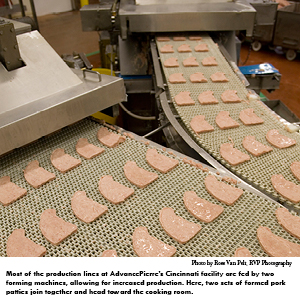NP: Discuss the main challenges when developing a

|
product that is to be formed (as opposed to other further
processes) — what are the top one or two factors you must take into account when creating this product/process?
Burroughs: The first challenge and objective is to clearly define what the customer really wants. Since current forming technology can produce a wide range of products with a wide range of attributes, we seek to ask as many questions as possible in the first stage of a project to help direct our development plan. Cost is also a consideration for our customers and an objective we must keep in mind. Oftentimes, a formed product is able to meet a client’s need while also solving the issues of size and shape variation that is common in whole muscle products.
NP: AdvancePierre Foods has formed products across all species — describe the differences that come into play when handling these different proteins during the forming process?
Burroughs: Beef, pork and poultry all respond differently during the forming process; in fact, even poultry items like chicken and turkey respond differently from each other when being formed. Beef and pork tend to tolerate a wider range of forming temperatures. Poultry is Iess tolerant of temperature variation and usually requires colder forming temperatures, which generates another set of challenges, such as damage to the protein structure, which we need to consider and solve. AdvancePierre Foods’ commitment to careful process design and control in manufacturing allows us to achieve very good consistency and product character.
NP: What are some of the more significant technological advancements you’ve seen over the last couple years when it comes to the forming process?
Burroughs: The ability to form at lower pressure has improved product quality, especially for poultry products. Lower pressure minimizes damage to the protein structure, which results in a more natural product. Also, the move to digital control systems has significantly improved the level of operator control and reduced product variation.
NP: What challenges remain? In other words, in your dream scenario, what would your forming lines be able to do that they maybe struggle with today?
Burroughs: An ideal forming line would be able to create products that are indistinguishable from whole-muscle cuts such as chicken breasts, pork chops and steaks. In the Protein Research and Development department at AdvancePierre Foods, we are committed to providing the best product for our customers — both through innovation and improvement in technology. For example, our sandwich product has textural character very much like whole muscle and performs better in microwave heating and holding than the similar whole-muscle item.
NP: Do you believe that processors such as AdvancePierre Foods have taken full advantage of the technology as it stands, or is there plenty of room for your company to expand in the realm of formed products?
Burroughs: While we are utilizing the best available forming technologies at AdvancePierre Foods, we recognize that there is always room for new developments and innovation in the marketplace. Whether that innovation is through the creation of a new product, a better product — including better flavor, texture and nutritional value — or a more cost-effective product for our customers, our research and development team strategizes and develops new ideas every day. We anticipate that the demand for formed products will continue to grow. As protein costs increase, customers will seek to deliver formed products that can be formulated to use less expensive raw materials.





Report Abusive Comment